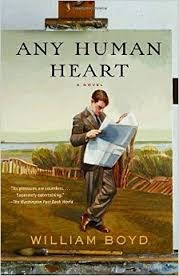Any Human Heart - A Novel
 The subtitle ‘a novel’ is included because William Boyd’s Any Human Heart is presented like a
scholarly edition of the diaries of Logan Gonzago Montstuart, complete with
introductions to each of the separate diaries that make up Montstuart’s life.
Indeed, at the end of the book, listed works by Montstuart include ‘Any Human
Heart: The Intimate Journals of Logan Montstuart’. One would wish this at least
of Boyd’s memorable character: that his life should extend beyond mere mortal
days (or Boyd’s rendition …). In other words, the effect of reading this book
is that the character does indeed appear to have lived. That is a remarkable
feat, even if it is the staple trick of any writer.
The subtitle ‘a novel’ is included because William Boyd’s Any Human Heart is presented like a
scholarly edition of the diaries of Logan Gonzago Montstuart, complete with
introductions to each of the separate diaries that make up Montstuart’s life.
Indeed, at the end of the book, listed works by Montstuart include ‘Any Human
Heart: The Intimate Journals of Logan Montstuart’. One would wish this at least
of Boyd’s memorable character: that his life should extend beyond mere mortal
days (or Boyd’s rendition …). In other words, the effect of reading this book
is that the character does indeed appear to have lived. That is a remarkable
feat, even if it is the staple trick of any writer.
Leaving Boyd out of all this for the moment, then,
Montstuart starts his diaries while in his last year at Abbeyhurst College,
where he shares various challenges with his two (lifelong) friends, Peter
Scabius and Benjamin Leeping. Like Montstuart, Scabius is bound for Oxford
University and then a life of writing; Leeping is set on taking on Paris and a
career in the sale of paintings. These early ambitions provide the arc of the
character’s existences: compared to the more successful novelist, Scabius,
Montstuart’s life is deeper and richer. Compared to Leeping, one is less
certain. Montstuart is not without moral scruples but he is essentially a
sensualist. For the reader his somewhat frustrating mistakes he makes are made
more acceptable by the yearning he has to live and live well. If Montstuart
appears to be in the thrall of his most basic sexual needs, his diary brings us
to some essential self, some human heart, that is more honest than a typical
novel with its constructs and expectations of ‘success’ in one form or another.
Montstuart’s intention is to render the personal onto the
page, rather than the political. Through this approach, we see his initial
naivety as he writes about the 1930s, even after his visit to Barcelona, and
Madrid, in 1936 and 1937. In a novel that covers a period running from the 1920s
to the 1990s, historical glimpses are included throughout. For example,
Monstuart’s experience of World War II is very limited (to missions in the
Bahamas and Switzerland) and yet his personal suffering is profound. Later, the
political events of the 1970s see him engage to a point with the restless
anarchy of anti-capitalists, though Montstuart will always be ‘an unreconstructed
tosser’ (in his wish for beauty, as well as freedom and fairness in life).
The biggest concern in Montstuart’s diary, apart from sex
and his career as a writer (he has some highpoints but this book in the main
makes you think how wise it is for novelists to have a second career going!) is
his personal relationships. These consist in the main of marriages and affairs,
of the heterosexual kind, as well as longstanding male relationships, with
Peter and Ben, and others. He is a man who engages with others, even while
protecting his independence and privacy – at the cost of real intimacy and
trust, one imagines. To read about a man’s life like this, and to understand
his flaws and his real emotions, is enlightening. It fills a space in literature
in an age when one might argue that the personal novel is more the domain of
the female novelist.
As Montstuart’s life draws to a close, his diary entries
become briefer and more poetic. Consider this little entry: Sultry, fuggy day. No leaf stirs.
Butterflies lurch and skitter through the delphiniums I planted around the
sundial’ (p.477). One doesn’t want Montstuart’s life or diary to end, with
writing such as this.



Comments
Post a Comment